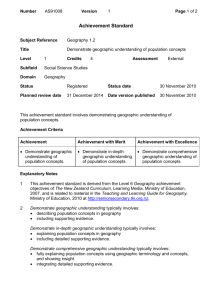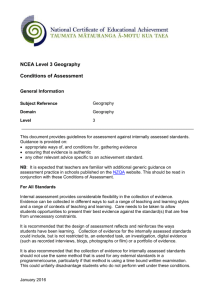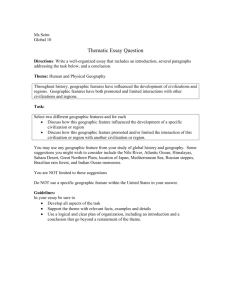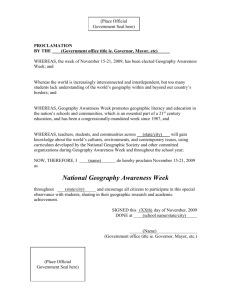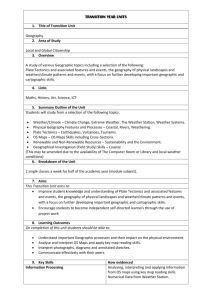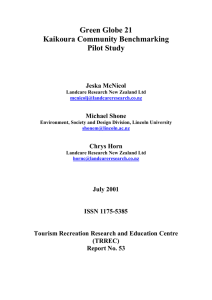Level 3 Geography internal assessment resource
advertisement
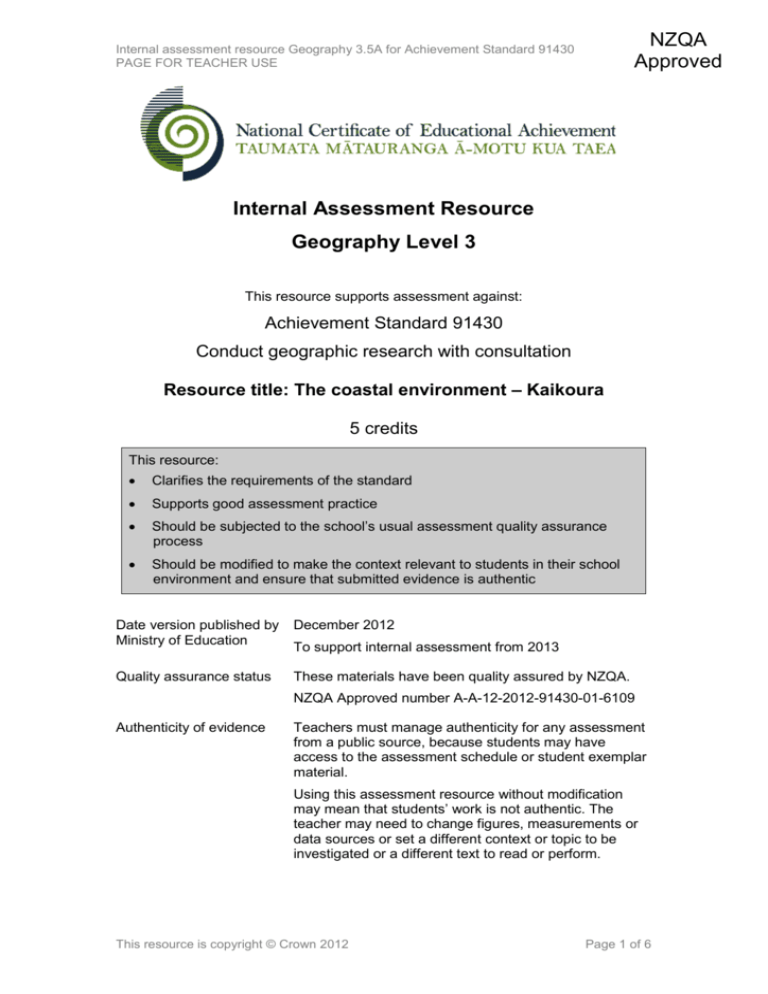
NZQA Approved Internal assessment resource Geography 3.5A for Achievement Standard 91430 PAGE FOR TEACHER USE Internal Assessment Resource Geography Level 3 This resource supports assessment against: Achievement Standard 91430 Conduct geographic research with consultation Resource title: The coastal environment – Kaikoura 5 credits This resource: Clarifies the requirements of the standard Supports good assessment practice Should be subjected to the school’s usual assessment quality assurance process Should be modified to make the context relevant to students in their school environment and ensure that submitted evidence is authentic Date version published by Ministry of Education December 2012 Quality assurance status These materials have been quality assured by NZQA. To support internal assessment from 2013 NZQA Approved number A-A-12-2012-91430-01-6109 Authenticity of evidence Teachers must manage authenticity for any assessment from a public source, because students may have access to the assessment schedule or student exemplar material. Using this assessment resource without modification may mean that students’ work is not authentic. The teacher may need to change figures, measurements or data sources or set a different context or topic to be investigated or a different text to read or perform. This resource is copyright © Crown 2012 Page 1 of 6 Internal assessment resource Geography 3.5A for Achievement Standard 91430 PAGE FOR TEACHER USE Internal Assessment Resource Achievement Standard Geography 91430: Conduct geographic research with consultation Resource reference: Geography 3.5A Resource title: The coastal environment – Kaikoura Credits: 5 Teacher guidelines The following guidelines are supplied to enable teachers to carry out valid and consistent assessment using this internal assessment resource. Teachers need to be very familiar with the outcome being assessed by Achievement Standard Geography 91430. The achievement criteria and the explanatory notes contain information, definitions, and requirements that are crucial when interpreting the standard and assessing students against it. Context/setting This activity requires students to conduct geographic research, with consultation, related to the natural processes and resulting natural features found in a specified area of the Kaikoura coastal environment. Conditions “With consultation” means students will develop their own research aim and research methodology and initiate discussion of these with you. Students may work in a group of up to four students to collect information required for their research. They will present their findings, analyses, conclusion(s) and evaluation individually. Guide students in their choice of presentation mode. The presentation method needs to allow students to develop ideas and show insight and analysis of their research. Students will be assessed on how comprehensively they conduct their geographic research. Resource requirements You will need to take students on a field trip. Students will need: field trip equipment – dependent on the student’s research aim, but is likely to include such things as: rulers, tape measures, Abney levels, stop watches, digital cameras, calculators, handheld GPS, floats, dye, sieves, sample bags, thermometers, or anemometers a research plan outline which may include: – focus for research (which may include an hypothesis/es) – what data will be collected – when and how often data will be collected – where data will be collected This resource is copyright © Crown 2012 Page 2 of 6 Internal assessment resource Geography 3.5A for Achievement Standard 91430 PAGE FOR TEACHER USE – how data will be recorded – how data will be presented secondary information such as topographical maps, and published information about the geographic environment from relevant websites. Additional information You need to be familiar with developing a concept map. Refer to Approaches to Building Conceptual Understandings (2009). Learning Media Limited. It is useful to organise and invite local expert guests to address the group, such as: Department of Conservation, Environment Canterbury, or Hurunui Regional Council. This resource is copyright © Crown 2012 Page 3 of 6 Internal assessment resource Geography 3.5A for Achievement Standard 91430 PAGE FOR STUDENT USE Internal Assessment Resource Achievement Standard Geography 91430: Conduct geographic research with consultation Resource reference: Geography 3.5A Resource title: The coastal environment – Kaikoura Credits: 5 Achievement Achievement with Merit Conduct geographic research with consultation. Conduct in-depth geographic research with consultation. Achievement with Excellence Conduct comprehensive geographic research with consultation. Student instructions Introduction Kaikoura is a unique coastal environment where natural features have been created by interacting processes. These interacting processes vary in spatial location, magnitude, and frequency. This assessment activity requires you to conduct geographic research (with consultation) into variations and interactions between coastal features and coastal processes within the Kaikoura coastal environment. Your research area is the Kaikoura coast and peninsula, specifically between the Hapuku River mouth and the Kowhai River mouth. Teacher note: You could use a different dynamic natural environment, such as a different coast, or a river or volcano. You will carry out this assessment using in-class and out-of-class time over three weeks, including a field trip to Kaikoura. This is an individual task, although you may work in a group to gather your data. You may choose your method of presentation, such as: a video or podcast documentary, a written report, a computer-aided presentation (with supporting notes attached), or a combination of these. You will be assessed on: your planning, and the collecting and recording of relevant data the accuracy and effectiveness of your presentation your use of a combination of spatial (map/s), statistical and visual data the thoroughness and depth of analysis of your finding(s), and conclusion(s) your detailed evaluation of the research process and the quality of your discussion of alternative research methods and their implications your use of geographic terminology and concepts. This resource is copyright © Crown 2012 Page 4 of 6 Internal assessment resource Geography 3.5A for Achievement Standard 91430 PAGE FOR STUDENT USE Task Plan and carry out your research In consultation with your teacher, complete a research plan that includes an aim or hypothesis for your research, and outline your research methodology. Undertake a field trip and collect relevant primary data individually or in a group of up to four students. Include a range of appropriate methods in collecting your data, such as: observing, measuring, précis-sketching, photographing, surveying, using questionnaires, interviewing and/or other relevant techniques. You may also collect relevant secondary data. Develop and present your report Develop and present for assessment a report. Include in your report: the aim for your research. This may be in the form of a hypothesis. a thorough research plan which outlines the research methodology evidence of all collected and recorded data relevant to the aim of the research – this can form an appendix to your report accurate and effective presentation of collected data including a map(s) and a combination of spatial, statistical, and visual forms, such as: annotated maps and diagrams, tables, photographs, graphs, and cross-sections, using the correct geographic conventions detailed and critical analysis of finding(s) from this presented data – you may choose to incorporate a concept map in the initial stages of this analysis as an aid to developing more in-depth analysis detailed conclusion(s) relating to the aim of the research a detailed evaluation of the research process, which fully analyses the strengths and/or weaknesses and how these impact on the validity of your findings/conclusions a critical evaluation of your research through a discussion of alternative research methods and their implications geographic terminology and relevant concepts in the analysis, conclusions, and evaluation references and/or footnotes where appropriate. This resource is copyright © Crown 2012 Page 5 of 6 Internal assessment resource Geography 3.5A for Achievement Standard 91430 PAGE FOR TEACHER USE Assessment schedule: Geography 91430 The coastal environment - Kaikoura Evidence/Judgements for Achievement Evidence/Judgements for Achievement with Merit Evidence/Judgements for Achievement with Excellence The student has conducted geographic research with consultation. The student: The student has conducted in-depth geographic research with consultation. The student: The student has conducted comprehensive geographic research with consultation. The student: identifies the aim of their research (in consultation identifies the aim of their research (in consultation identifies the aim of their research (in consultation with their teacher) and completes a thorough research plan including specific methodology, then collects and records data presents a combination of spatial (map/s), and statistical and/or visual data, mostly using the correct geographic conventions analyses the findings (Their analysis may be in the form of a broad summary, captions, or statements for each piece of data presented.) provides a conclusion(s) that relate to the aim(s) of the research (These conclusions may be broad but must link to the collected data.) provides an evaluation of the research, analysing the strengths and/or weaknesses of their research process and how this may have affected the validity of the research findings (The evaluation is not comprehensive and may only include partial evaluation of the methodology.) supports their analysis of the finding(s), conclusion(s) and evaluation with evidence, geographic terminology, and relevant concepts. with their teacher) and completes a thorough research plan including specific methodology, then collects and records data accurately and effectively presents spatial (map/s), statistical and visual data, using the correct geographic conventions (The presentation allows for easy analysis, and communicates the information clearly.) analyses the findings in detail (Their analysis may be in the form of summary statements for each piece of data presented.) provides detailed conclusion(s) that relate to the aim of the research (These conclusions are accurate and will have detail, in the form of specific examples, which are linked to the presented data and findings.) provides a detailed evaluation of the research, analysing in detail the strengths and/or weaknesses of their research process, and analyses in detail the impacts on the validity of their findings and/or conclusions includes explanations about how specific strengths with their teacher) and completes a thorough research plan including specific methodology, then collects and records data accurately and effectively presents a combination of spatial (map/s), statistical and visual data, using the correct geographic conventions (The presentation allows for easy analysis, and communicates the information clearly.) critically analyses the findings (Specific examples are given throughout to support their analysis.) provides detailed conclusion(s) that relate to the aim(s) of the research (These conclusions are accurate and will have detail in the form of specific examples from the presented data and findings.) provides a critical evaluation of the research process by building on the detailed evaluation required for Merit and discussing alternative, appropriate research methods and their possible implications thoroughly supports their analysis of the finding(s), conclusion(s) and evaluation with relevant evidence, integrating concepts, and geographic terminology. and/or weaknesses impact on specific finding(s) and/or conclusion(s) and reasons for this supports their analysis of the finding(s), conclusion(s) and evaluation with relevant evidence, applying concepts, and geographic terminology. Final grades will be decided using professional judgement based on a holistic examination of the evidence provided against the criteria in the Achievement Standard. This resource is copyright © Crown 2012 Page 6 of 6


